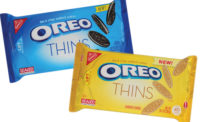Desserts dare to be different through better-for-you ingredients and portion control
From better-for-you to simply better-tasting, desserts must innovate to compete.

courtesy of Mamie’s Pies

courtesy of Katz Gluten Free

courtesy of mmmpanadas and the National Mango Board

courtesy of Mondelez International

courtesy of Almond Board of California





With better-for-you trends top of mind across the food industry, how does an indulgent category like desserts fare?
While traditional desserts still hold the lion’s share of sales, innovative brands continue to chip away at market share.
Cookie is the largest category in desserts, and the products gain an edge as highly snackable treats. Cookies grew 2.09 percent in dollar sales to $8.5 billion for the 52 weeks ending Dec. 31, 2017, per IRI, Chicago. Mondelez International leads the category, but saw sales dip 0.18 percent to $3.2 billion. Private label grew 8.82 percent to $1.4 billion, and McKee Foods rose 4.32 percent to $607.4 million. Nabisco
The Mondelez Nabisco business saw growth via its BelVita brand—one that crosses dayparts and has strong better-for-you appeal—up 18.65 percent to $344.4 million. At the same time, indulgent offerings from Mondelez like Nabisco Oreo cookies fell 4.50 percent to $709.4 million, Chips Ahoy fell 3.01 percent to $640.5 million, and Oreo Double Stuff varieties fell 3.16 percent to $262.2 million.
Lenny and Larry’s Complete Cookies provide another strong example of the potential for better-for-you cookies. The brand grew 55.17 percent to $104.6 million, per IRI, and offers cookies enriched with protein and fiber; its chocolate chip variety has 16 grams of protein and 10 grams of fiber per cookie.
Pies and cakes grew by only 1.28 percent to $2.0 billion. While private label leads both segments, sales were relatively flat. Standout performers in cakes included The Hershey Co., up 21.0 percent to $23.7 million, and Rich Products Corp., up 50.85 percent to $15.7 million. In pies, Jessie Lord Bakery grew by 13.27 percent to $29.1 million, and Specialty Bakers Inc. rose 10.37 percent to $23.2 million.
Frozen pies dropped 4.92 percent to $500.1 million, with the top two companies—Schwan’s Co. and Conagra Brands—both seeing losses (although together they account for $438.22 million in sales and over 87 percent of category share…). Meanwhile, private label grew by 49.16 percent to $12.4 million and Willamette Valley Fruit Co. rose by 48.30 percent to $2.0 million.
Refrigerated cheesecakes demonstrated strong growth, up 16.79 percent to $312.2 million. Growth was led by private label offerings, which make up the majority of the market share and grew 12.74 percent to $188.4 million. The Father’s Table, in the No. 2 slot for the segment, grew 5.15 percent to $55.5 million.
A better-for-you dessert?
In order to catalyze new levels of growth, dessert manufacturers might need to offer options that edge closer to the better-for-you trend by adjusting serving sizes—and possibly adding new convenient, portable product formats.
“Customers are still obsessed with snacking and eating on the go,” says Katherine McSpadden, application specialist, bakery and prepared foods, Quadra Ingredients, Vaudreuil-Dorion, Quebec. “Portion control is therefore still important to this segment, so that consumers can still have their daily indulgences, but in smaller, more-appropriate serving sizes.”
Handheld sizes are on trend at Rich Products Corp., Buffalo, NY, says marketing manager Amy Vinette, since they allow for convenience and portability. “We are also seeing a rise in demand for bite-sized items that can easily be consumed while on the go.”
The days of the giant cookie are waning, notes Pam Stauffer, global marketing programs manager, Cargill, Minneapolis. Instead, she notes, product developers are developing dessert treats with the same great taste, but with fewer calories and less sugar. “Think of it as ‘indulgence light,’” she says.
Mamie’s Pies, San Rafael, CA, is appealing to this trend with single-serve desserts. “Our individual, handheld, all natural, unbaked pocket pies check all the boxes,” says Kara Romanik, founder. “I’ve read that the trend to single serving is known as ‘mini mania.’ With the changing landscape of our households, more and more families are looking for convenience, but will not compromise on quality.”
Ingredient scrutiny
The biggest better-for-you issue impacting desserts today is, undoubtedly, how manufacturers are handling sugar. “At the moment, we are seeing a move toward desserts that offer reduced sugar or use of a sugar alternative proposition in a bid to present a healthier product,” explains Rosemary Shrager, celebrity chef, owner, Rosemary Shrager Cookery School, Tunbridge Wells, England, and a chef ambassador for the California Dried Plum Board, Sacramento.
McSpadden explains that lowering the sugar content of desserts will be more important as the U.S. and Canada introduce new guidelines around labeling sugar. “Consumers are looking more closely at nutritional labels, ingredients lists and the grams of sugar per serving.”
Quadra Ingredients addresses this challenge with a green banana flour, which formulators have used to successfully create a grain-free chocolate chip cookie. Not only will this type of product appeal to gluten-free trends, but it also is nut-free, non-GMO and lowers overall sugar content.
According to Kristen Fields, co-founder and CEO, mmmpanadas, Austin, customers are looking for plant-based sugar alternatives like coconut sugar and date syrup, which are seen as less processed than white sugar. Additionally, fruit-based desserts are on her radar.
“Wild Maine blueberry is definitely a flavor trend with half the sugar of cultivated blueberries,” says Romanik. “They’re high in antioxidants, and are a good source of vitamin K, vitamin C, fiber and manganese.”
Fruit-based desserts hit two better-for-you trends, says Shrager: natural ingredients and natural sugar sources. “Consumers are looking for products that boast natural ingredients in a bid to move away from over-processed foods,” she says. “So, we are seeing the roll-out of more healthy, naturally sweet desserts where the sweetness is derived from natural source, such as California prunes.”
Natural sweeteners suited to use in desserts include dried fruit, applesauce, sorghum and molasses, suggests Karen Holmes, chef/owner, Karen’s Bakery & Café, Folsom, CA, and a chef ambassador for the California Dried Plum Board.
But the better-for-you dessert movement is about more than just cutting or replacing sugar. “People are turning to foods that may have been previously overlooked or undervalued,” explains Holmes. She suggests nut milks and butters as better-for-you options that will resonate with consumers. She also recommends alternative flours, like almond, tapioca, potato and rice flour for dessert brands looking to develop gluten-free offerings that will appeal to all consumers.
Dairy alternatives can also help build a following. “Recognizing the improved sustainability in plant-based products over animal-based products is one reason for the rise in popularity, and the other is that it is easier to digest nutrients that come from Mother Earth,” says Jill Motew, founder, Zemas Madhouse Foods, Highland Park, IL.
There is an opportunity, then, for desserts with functional ingredients: cookies with protein or seeds, or cakes made with sprouted grain flours, adds Motew. To meet this trend, Zemas recently launched a line of ancient whole-grain mini cookies that are made with super-seeds and gluten-free flours. “These better-for-you cookies are top eight allergen-free, just like our baking mixes, and they are filled with functional flours and seeds.”
Flavor trends
Dessert flavor trends are following those in the food industry overall, demanding elevated versions of tried-and-true favorites, as well as more-adventurous profiles.
McSpadden has noticed a back-to-basics approach this past year, with consumers seeking classic flavors like vanilla and chocolate, but with an upgrade—such as pure Belgian chocolate vs. milk chocolate. “Flavor trends are also riding the wave of the local food movement. We are seeing trends in seasonal varieties and locally sourced ingredients translated into flavors such as pure Canadian maple flavors.”
Marret Arfsten, product line and marketing leader, Cargill Cocoa & Chocolate, points toward premiumization taking shape via desserts with a higher cacao content, or using cocoa powder as a topping.
Flavors on the rise at Cargill include citrus flavors like orange, lemon and lime, brought to life in pairings such as honey and lemon, or raspberry and lime, adds Arfsten. “Taking exploration a step further, exotic and tropical flavors are entering the dessert space, such as passion fruit and matcha tea. Matcha is being used for everything from cake glazes to cheesecakes and macarons.”
The trend toward adventurous and exotic flavors that has transformed the snack market is making its way to desserts, says Shrager. “A key flavor trend is the inclusion of lesser-known spices in desserts.” One example she notes is using chile in sweet, as opposed to savory, applications.
Desserts can use alternative sugars and flours, include nutritious ingredients, and pack a flavorful punch. “It’s a perfectly achievable goal,” says Holmes. “We just have to break out of our traditional thought processes and embrace new opportunities to learn and taste new things.” SF&WB
Market Trends Product Spotlight
Almond Butter Truffles
The concept for Spiced Chocolate Almond Truffles, featuring almond butter, cacao nibs, honey, almond meal, almonds, puffed quinoa, coconut sugar, vanilla, cinnamon and ancho chili powder, hits multiple on-trend marks taking shape in desserts today. In order to learn more about the concept, we reached out to Rob Corliss, chef and founder, All Things Epicurean, Nixa, MO, who developed the recipe for the Almond Board of California.
With this recipe, I wanted to showcase the versatility of California almonds in one concept, bringing to life the dynamic duo of almonds and chocolate in a new, sensory-driven format.
I took inspiration from the chocolate truffle and modernized it with premium ingredients and unique flavor combinations. The twist was making the truffle savory, with simple back notes of natural sweetness, and prominently featuring almonds as a heathier base, as opposed to chocolate.
As plant-based snacks continue to see industry growth, I’m always looking for new ways to ideate around them. The Spiced Chocolate Almond Truffle took on global inspiration, featuring ancho chili powder. The other two variations I developed are a Curry Coconut Almond Truffle and a Hibiscus Orange Almond Truffle, but the flavor innovation possibilities are truly endless.
Texture is such a crucial element of recipe development. The first sensation comes from the rustic spice accent coating. Then, as you bite into the truffle, the creamy smoothness is highlighted by pops of puffed quinoa and chopped almonds.
The Spiced Chocolate Almond Truffle is very much a hybrid, hitting multiple consumer desires. It is both indulgent to satisfy a premium craving, and satiating to tide one over in-between meals. I would describe it as a “feel good,” “better for me” snack offering. Additionally, the truffle has the additional benefit of being gluten- and dairy-free, attributes which resonate with health-minded consumers.
Looking for a reprint of this article?
From high-res PDFs to custom plaques, order your copy today!










